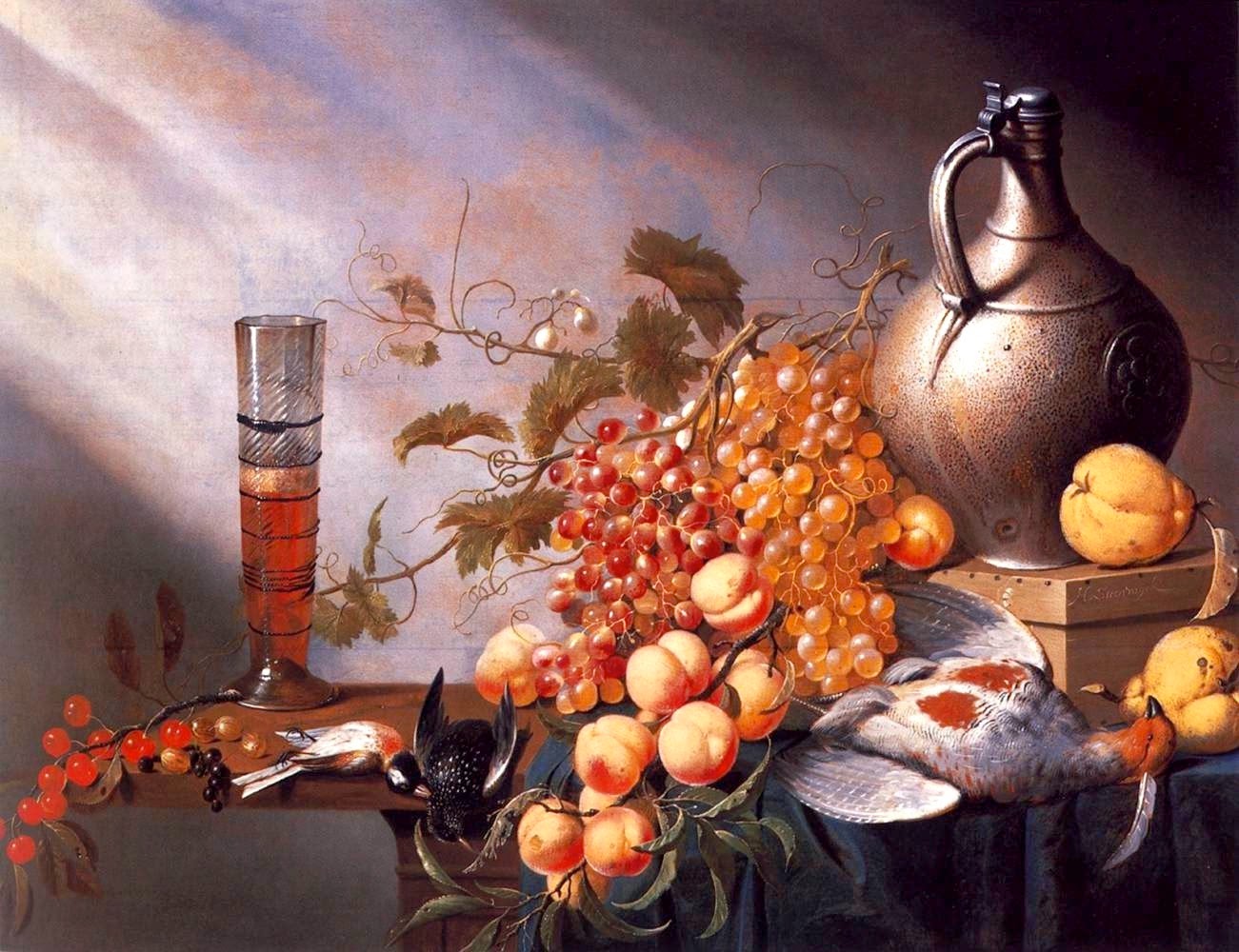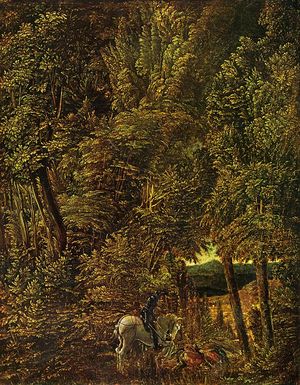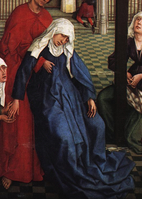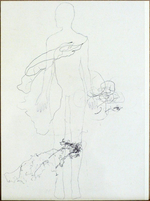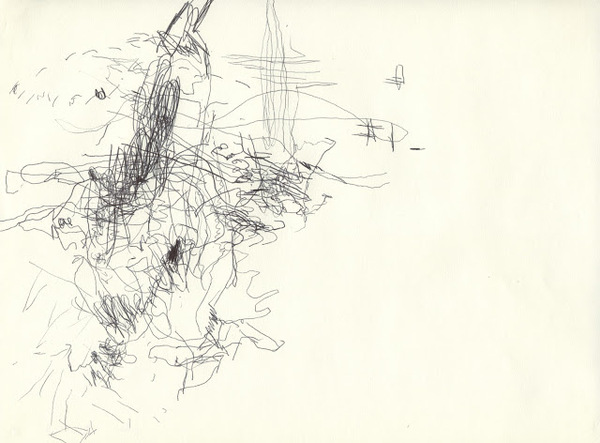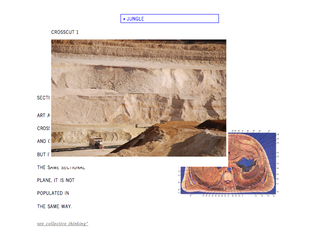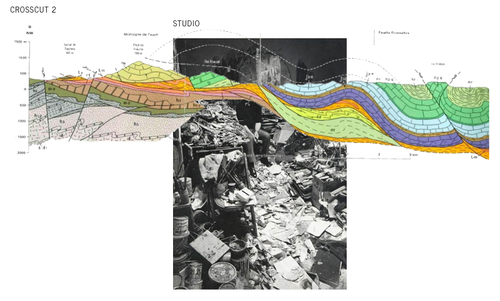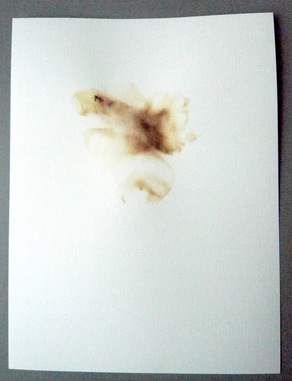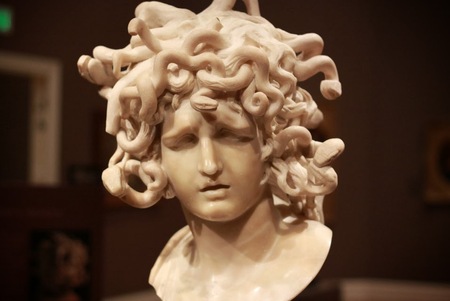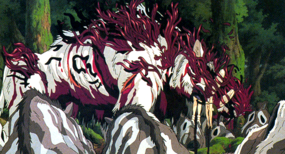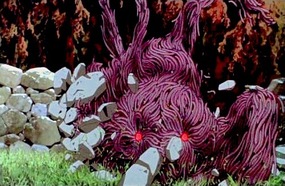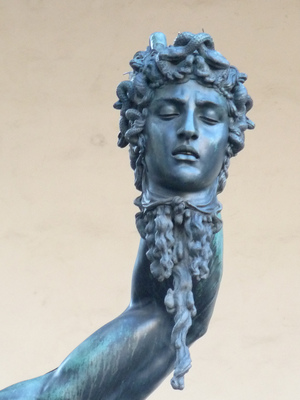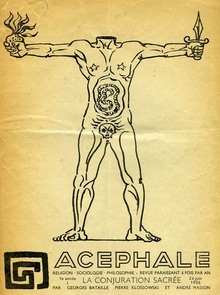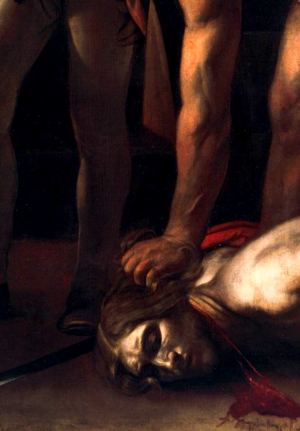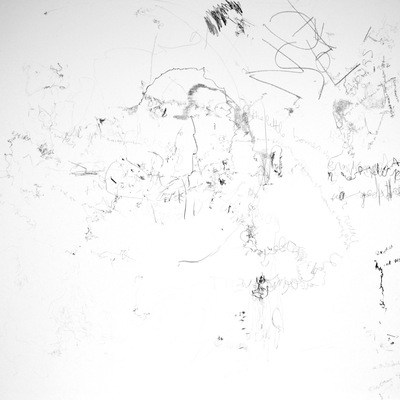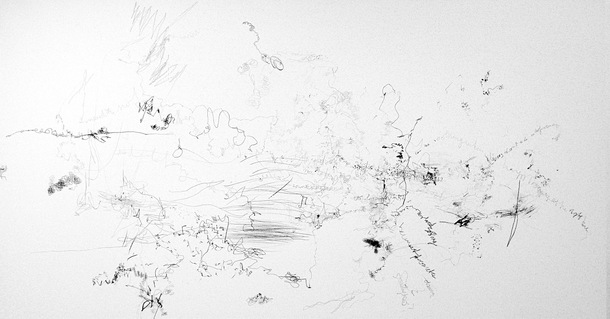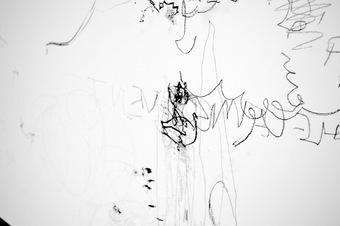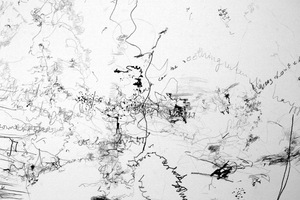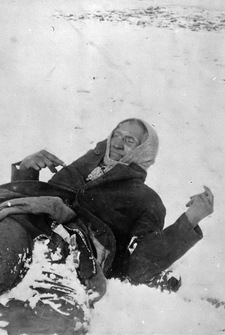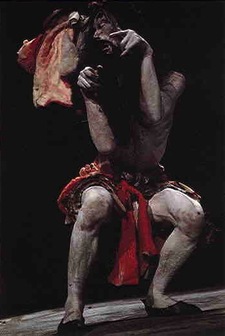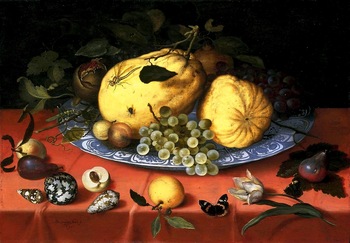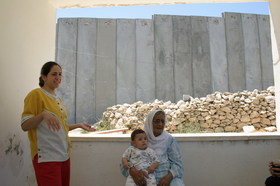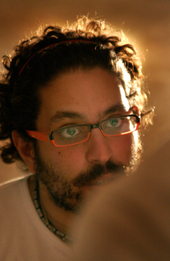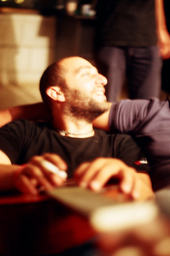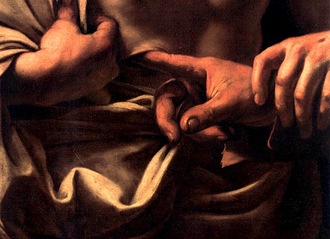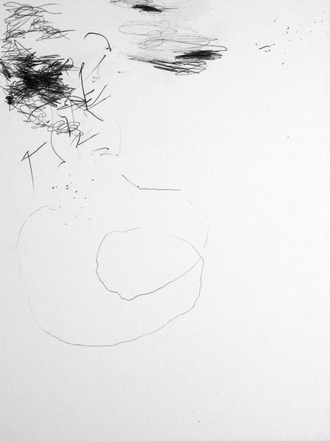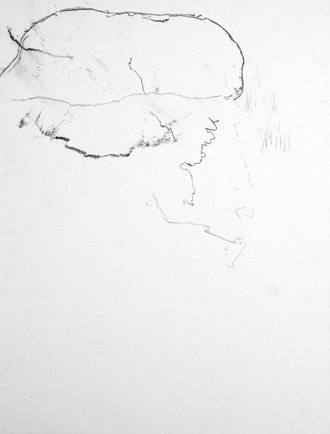Strange Fruit
voice 2
Studio
crosscut 2
jungle
This digital landscape will be soon an evidence of it: when working, I engage myself in a complex, ever expanding web of references, images, ideas and feelings. It goes all the same for the practices I make use of to create. I invent a lot of them and combine them in many nuanced ways, calling for new hybrids to appear. The basis of my process is to generate an overwhelming environment. A jungle that will ask me to find out the necessary skills to survive in it. My trajectory to get out, successfully or not, is the piece of art I share with the audience. Therefore, the multiple elements involved in the making are not aimed at being progressively channelled in a more simple, more communicative format. I am the one to be channeled within the intricated landscapes of my process. Another way to say it is that the piece is a cross section, showing the accumulation of heterogeneous elements, layered and bleeding into each other.
While expressing the proliferation at work in my approach of art, both metaphors (the jungle and the crosscut) also indicate the correlative consequence in my aesthetics: the outcome is condensed. Condensed as is a slice of stone, condensed as is your behavior when you have to be aware of any signs by which to orientate yourself in a bushy unknown surrounding.
A.Altdorfer, St.Georges in the Forest, 1510
crosscut 1
cross section
sectional plane
ART AND PHILOSOPHY
CROSSCUT THE CHAOS
AND CONFRONT IT,
BUT IT IS NOT
THE SAME SECTIONAL
PLANE, IT IS NOT
POPULATED IN
THE SAME WAY.
oracular archeology
The present page takes shape by a progressive digging up in my work. A process which is akin to the activity of an archeologist or a geologist. Of course I acknowledge the paradox, and do enjoy it. Since the ground I excavate -a mixture of memory and intuition- is a highly metamorphic one, no chronological order prevails here. No history could be deduced from what we will discover. Such a feature is nevertheless congruent with the nature of the depth that is searched for here. It is not a depth granting us with the legitimacy of the past, as authentic foundations would do. The journey I embark upon is not towards a pre-existing and fundamental core to be progressively unveiled as surfaces are peeled away. What I am aiming at is a continuous process by which the past is reconfigured again and again, in ways that open in it a gap of always remodeled contours. A gap, or a depth indeed, created by the concern of the present to make its voice resonate in the past in order to be heard by the future.
to index
flow
cut
no title
Please scroll to the right.
brothers and sisters 1
brothers and sisters 2
brothers and sisters 3
brothers and sisters 4
embodying indexing 2 (Julien)
A gesture is an event between movement and language.
waves crashing
eventfulness
ONE ANOTHER’S FOOL
Untitled (Hand Circle), by Bruce Nauman, 1996
embodying indexing 1 (Anouk)
The score on the music stand :
écume
language is the foam of movement crashing as a wave against a gesture.
embodying indexing 3
loop 2
Each of the drawings on the side (“embodying indexing 4”) is an outcome of a similar process. After I had edited a part of the present Internet page (in this instance the part shown below as a screenshot), I drew it on paper. Working eyes closed and granting autonomy to the gesturality of drawing, I was not aiming at representational accuracy. The activity of drawing was a way to make present to myself the pictorial, conceptual and proprioceptive associations afforded by the initial image. To make those associations present and to process them, which is to think and to feel them.
embodying indexing 4
loop
Each of the drawings on the side (“embodying indexing 3”) is an outcome of a similar process. After I had edited a part of the present Internet page (in this instance the part shown beside as a screenshot, “hybrid”), I drew it on paper. Working eyes closed and granting autonomy to the gesturality of drawing, I was not aiming at representational accuracy. The activity of drawing was a way to make present to myself the pictorial, conceptual and proprioceptive associations afforded by the initial image. To make those associations present and to process them, which is to think and to feel them.
Hybrid
brothers and sisters 5
apparition
disappearance
annunciation 1
click here
annunciation 2
The Annunciation is the biblical episode where Mary is told by archangel Gabriel that she will give birth to God’s son. Since Mary is and will stay virgin, and since God can’t be thought of as anything near to a human inseminator, theology tells us that Mary inseminated herself, thanks to the performative effect of the message Gabriel brought to her. God’s Word awakened in her the potentiality of being pregnant of the divine. This idea meets the “logos spermatikos” notion, the “generative Word”, the generative principle that impregnates the whole Creation and that leaves a spark of the divine in every human. From this perspective, the Annunciation is the parable of these moments where the Mary’s we are all meet a message (a sign, a situation, a person) that activates in them the growth of something larger than themselves. It doesn’t need to be something spectacular. It means to experience yourself, in any kind of situation, as the vehicle of some streams you can’t direct, you can’t own, but you could nevertheless bathe yourself in.
That could describe how I am trying to work in the studio with the performers I am collaborating with. The first site of my creative gesture is the interiority of the performers collaborating with me. Yet I can’t go there, and it is not the point. The point is that they will let it grow, let it blossom and eventually they will deliver it. My job in that is to convey suggestions that would support the performer’s interior journey. Just like Gabriel, I am a messenger, someone who connects. I connect, whenever I manage, the performers to the otherness within themselves. You could think of an hypnosis of sorts (that shouldn’t be seen as a way to implement orders or ideas in people, but as a way to call for the unfolding of latent potentialities within them) and Gabriel as a hypnotist of sorts. In Candomblé, a possession cult from Brazil, the first entity to be honored in any ceremony, is Eshu, the messenger, the intermediary between humans and Orishas (the spirits). Only when he has been welcomed, worshippers could be manifested by their deities, receive them in their bodies and become the vehicle of the spirits’ dance.
ghost
A ghost is not a figure of absence. It is a figure of that which is insistently present. This is the point of haunting. Being there when everything converges to say it is impossible for it to be there. The ghost notifies that the current situation is unsolved. It occupies gaps and impedes coalescence.
the real
A ghost is a figure of the real. The real as that which happens. The real as the impossible, as Lacan would say. Not to mean that it doesn’t exist, but on the contrary to mean that it happens. It wasn’t there, waiting to be discovered, it happens and it does so in a way that can’t be framed, that can’t be appropriated. It challenges our understanding, our categories, our modes of making sense. The real is a haunting ghost, invisible, unlocalizable. It impregnates the whole situation. It happens through everyone and everything involved but it does not belong to anyone, nor to any specific place.
brothers and sisters
Before getting pregnant of Jean-François, my elder brother, my mother went through a large amount of miscarriages. I would say five, so I am sure not to exaggerate. But actually it would not come as a surprise to be reminded it was even more. Once, I had been invited to represent the relationship between my parents, my siblings and myself by placing on the floor papers signifying each individual. The potential brothers and sisters had to be present as well, next to the actual members of the family. In my set-up my mother, my father, Jean-François and I were quite spread apart, each facing a different direction. All together, we were forming a pattern whose logic, if it had any, would be hard to grasp. The five virtual unborn siblings were on the contrary creating a very recognizable shape, a circle surrounding us. Each of them looking away from us, they were reassuring figures. Protective, filtering, like a membrane would do, the exchanges with the outside. More importantly, they were a flexible, porous container guaranteeing a togetherness for elements that would otherwise have seemed unrelated.
In this instance, I composed my family as I usually compose drawings or choreographies. Distinct elements maintain reciprocal heterogeneity, keeping their relationship unsolved, in tension. Yet they are bathing in an invisible, inexplicit common resource by which they are linked to one another. This is the meaning of the name I give to the research I develop for four years : phréatiques, the French adjective used to describe the underground water layers feeding the wells and water sources, a collective subterranean pool for diverse autonomous flows.
potentialities
When working in the studio with my collaborators, I am used to contrast “spontaneity” with “intuition”. Often, we work on inhibiting the former to give a chance for the latter to arise. By spontaneity, I mean here the drive to coincide with the present. When spontaneous, one draws upon acquired skills and habits to react as immediately as possible to the future flowing towards oneself. It comes from an urge to react, to engage oneself. By inhibiting this inclination, we open up a gap in the flow of causality, we create a suspension, we make of ourselves a platform where diverse potentialities detach themselves from actuality. The time and the space is made for them to be co-present in their complexity and to start to ferment. Intuition is the name I give to this pragmatic practice of letting a biotope of potentialities breathing within the flow of time passing.
self-interfering waves
For quantum physics, an electron behaves as a wave (a virtual wave of potentialities) until it is being measured. Then it appears as a particle. If you shoot an electron through a double-slit, without measuring it, the wave of potentialities reacts as an actual wave of matter would do. It splits itself into two diffraction patterns that interact. Where a crest meets a trough, the concentric circles cancel each other out and where a crest meets a crest, they intensify each other. If you do start to measure in order to know what is the actual trajectory of the electron, if you want to know through which slit it went, you collapse the wave of potentialities to one particle, univocally situated in one single place in one single moment. So as long as it is not pinned down, the electron, that we are used to think of as a discrete and coherent entity, the electron could interfere with itself as it is being split in distinct potentialities of itself. A process that both blurs it (aspects of it are cancelled, information are lost) and intensifies it.
About the double slit experiment :
http://www.youtube.com/watch?v=Q1YqgPAtzho
ghost dance
The Ghost Dance is a religious movement of the Native Americans. Its prophet, Jack Wilson (also know as Wovoka), started to preach its principles in 1890. It spread quickly among many tribes that adapted it to their own belief systems. Consisting in a circle dance, common in the Native Americans’ rituals since prehistoric times, the practice was aimed at reuniting the living with the spirits of the dead and at bringing peace and prosperity. Jack Wilson prophesied a peaceful end to the white expansion if people would take up the Ghost Dance.
The success of the movement throughout the region worried the U.S. forces who tried to forbid it. It was notably thought to contribute to the Lakota resistance. The spiritual leader Sitting Bull died in a gunfire exchange while being arrested for failing to stop the practice among his people. Shortly after, 153 Lakota and 25 U.S. soldiers died in the Wounded Knee massacre. The chief Spotted Elk was among the victims, beside many women and children. Eventually interest and participation in the Ghost Dance movement dropped dramatically for fear of continued violence against practitioners of the religion. It is nevertheless still practiced today, by the Caddo Nation. (adapted from Wikipedia http://en.wikipedia.org/wiki/Ghost_Dance )
portrait 1
portrait (on paper) 1
portrait 2
portrait (on paper) 2
portrait 3
portrait (on paper) 3
portrait 4
portrait (on paper) 4
portrait 5
portrait (on paper) 5
combustion
fuel assembly
As we are composing with signs, representations emerge. Be they visual, conceptual, choreographic, they tap into issues regarding the world, our society and our lives. Yet they are not aimed at being addressed as such, becoming themes for the work. They are rather a fuel assembly. Potential energy that is put into motion by our scores and that in turn moves the performers. We are brought to a vibrant liveliness by engaging ourselves with representations that are made to matter to us through our scores. Within their meaning, their connotations, their shape and colors, within their history, representations hold a potential energy that we are seeking to deploy, as a fire would do with the matter it burns.
spotted elk (1826 - December 29, 1890)
shadow of a ghost
pow-wow
Scroll down for English translation.
Isabelle Stengers: On a pas mal de documentation, et ça continue d’ailleurs, sur la manière dont les Amérindiens d’Amérique du Nord font ce qu’on appelle leur pow-wow. Et bien on peut dire que c’est leur manière de faire de la politique. Et c’est aussi un art de composition, c’est à dire que les humains ne sont jamais les seuls réunis.
L’ensemble des rites, calumets etc. sont là pour convoquer ceux avec qui il faut penser et qui sont des non-humains, des invisibles mais dont la présence fait qu’on parlera autrement. Un peu comme pour l’”ordre du monde” dans le palabre. On parlera autrement parce qu’on n’est pas entre humains. Il y a une artificialité cultivée, des contraintes cultivées, qui fait qu’on est jamais dans l’ordre du débat mais dans l’ordre de “nos paroles ne nous appartiennent pas véritablement, et c’est pour cela qu’elles peuvent se composer, alors que nous, nous ne savons pas comment”
Donc on quitte le projet politique pour le processus politique.
Julien Bruneau: Oui, encore une fois, puisque vous insistez, vous liez composition au fait qu’il y ait aussi des non-humains, ça…
IS: Oui
JB: Implicitement ça ramène aussi à cette question d’hétérogénéité.
IS: Ca ramène à cette question à laquelle je reviens toujours: on a donné à la situation le pouvoir de nous rassembler. Une phrase que personne n’a dite mais avec laquelle il faut penser, c’est quelque part aussi un non-humain, parce que justement il n’y a pas d’énonciataire qui collerait à cette phrase.
S’il y a composition entre les humains, c’est parce que ça passe aussi par des formes de rite, des formes de présences actives… qui peuvent être toute sorte de choses, parce que c’est justement leur efficace à transformer les rapports entre humains qui est le point. Ce n’est pas « sont-ils dignes ou pas ? »
Mais quand je lis des trucs sur comment faisaient les Indiens, je pense que éventuellement, c’est quand les colons américains ont compris que d’une manière ou d’une autre les peuples indiens fonctionnaient sans chef, sans hiérarchie, qu’ils ont réactivé l’idée de démocratie. Enfin, c’est un grand mystère, au XVIIIème siècle, pourquoi la démocratie qui était mal vue, devient un idéal? Et ça vient d’Amérique. Et bien à mon avis ça vient d’une expérience qu’ils ont eue avec les Indiens. Les chefs des Indiens ne sont jamais chef une fois pour toutes, ils ne le sont que dans la mesure où ils sont reconnus comme tel.
Donc, ça a traversé l’océan mais en se remettant sur le mode grec de l’agora en oubliant que chez les Indiens ce n’était pas du tout de l’agora. C’est redevenu vulnérable à tout ce que les Grecs avaient critiqué en disant que ça ne faisait pas partie de la démocratie.
JB: Et donc qui serait… Est-ce qu’on pourrait nommer ce que les Grecs ont critiqué?
IS: Les Grecs, enfin Platon a été le pire, mais chez les Grecs les effets de séduction, les effets de terreur, les effets d’influence, les effets de conformité, etc. étaient de très gros défauts auxquels on ne voyait pas tellement comment remédier.
JB : Et par contraste, dans la situation des pow-wows?
IS : Si on parle d’art de composition, c’est justement que l’ensemble de ces effets fait partie du problème auquel l’art de composition s’adresse. On ne va pas avoir les mêmes effets de séduction si on parle en présence d’ancêtres ou des vent sacrés… On sera tenu sans que ce que l’on dit soit dicté. Etre tenu sans être contraint, enfin être tenu ou contraint sans être limité, c’est un peu ce que j’ai vu avec le palabre, ça rend les gens différents et ça rend leurs énoncés composables.
/
Isabelle Stengers: We have quite a bit of documentation, and actually there’s still more being collected, on how the Native Americans organize what we call their pow-wow. We can say that it’s their way of doing politics. And it’s also an art of composition, that is, where humans are never the only ones at these meetings.
All of these rites, calumets, etc… are in place to convoke those with whom we ought to engage in thinking and that are non-human, invisible ones whose presence help us to speak differently. As is the case in palavering with the “world order”. It makes us speak differently because we aren’t just amongst humans. There’s a kind of cultivated artificiality, cultivated constraints so that we’re never just in a kind of debate but in a kind of “our words do not truly belong to us, and this is why they can compose themselves, whereas we ourselves don’t know how to.”
So we abandon the political project for a political process instead.
Julien Bruneau: Yes. So once again, since you insist, you associate composition with the fact that there are also non-humans, that…
IS: Yes…
JB: Implicitly that also brings us back to that question of heterogeneity.
IS: It brings us back to that question: we gave the situation the power to gather us. A phrase that no one has said but that we must use in order to think, is also a kind of non-human, precisely because you cannot attach the phrase to a speaker. If composition is possible among humans, it’s also because it passes through ritual forms, forms of active presences… which can be anything, since the point is that they’re effective in transforming relationships between humans. It’s not about “are they worthy of it or not?”
But when I read about how the Indians did this, I think that the American colonists probably understood that Indian peoples functioned without a leader, without hierarchy, and that’s when they reactivated the idea of democracy. I mean, it’s a great mystery. In the 18th century, how did democracy, which was considered a bad thing, suddenly become an ideal? It comes from the Americas. Well, in my opinion, it comes from their experience with the Indians. The Indian chiefs are never chiefs forever. They only remain chiefs as long as they are recognized as such.
So it crossed the ocean but based itself on the Greek model of the agora, disregarding the fact that for the Indians, it had nothing to do with the agora. It fell prey to all those things the Greeks had critized as not being part of a democracy.
JB: And that would be… could we put a name on what the Greeks criticized?
IS: The Greeks, well Plato was the worst, but in Greek times, the effects of seduction, of terror, of influence and conformity, etc… were great faults that no one really knew how to correct.
JB: And in contrast to the pow-wow situation?
IS: If we talk about an art of composition, it’s that it addresses precisely how all of these effects, together, are part of the problem. We won’t see the same influence of seduction if we speak in the presence of ancestors or sacred winds… We’ll be held to our word without being dictated our word. To be held to something without constraint, or rather to be held or constrained without being limited, that’s a bit what I saw in the palaver. It makes people different, which makes it possible to compose the statements they make.
medusa
swarm
medusa (Cellini)
medusa (Cellini) 2
Medusa (Cellini) 3
acéphale
(headless)
acéphale 2
(headless 2)
noise 1
noise 2
detail (noise 1)
detail (noise 1)
detail (noise 2)
We are venturing into the zone
OF INDISTINCT BORDERS WHERE
ARTICULATED MEANING EXTRACTS
ITSELF FROM ITS MILIEU: NOISE.
A NEVER ACHIEVED WORK,
A SISYPHEAN ONE, ABSURDLY
AND NECESSARILY REITERATED
TIME AND AGAIN.
Not every composition is political in the direct sense of the term. BUT TRYING TO DO POLITICS WITHOUT
HAVING CULTIVATED THE ART OF COMPOSITION IN DIFFERENT REGISTERS, THIS MIGHT HAVE BEEN OUR MISTAKE.
dancing the dark
The corpse of Unpan Glešká (Spotted Elk) and the dance of Tatsumi Hijikata. The Ghost Dance (see “Ghost Dance” on your left) and the “Dance of Darkness” (Ankoku Butoh). Two dance practices spiritual and political at once, invoking the dead to find a new way to live. Hijikata’s approach to dance was embedded in a rejection of both the traditional Japan and the modern influence of the U.S.A. -prominent in the country after WW II-, a critique fueled by its reading of subversive French literature (Genet, Artaud, de Sade). His artistic and spiritual questioning of what life could be was intimately linked to his fascination for death, obscenity and non-humans (animals, sea-weeds…).
myself as indian
strange fruit (song)
strange fruit (Lyrics)
SOUTHERN TREES BEAR A STRANGE FRUIT,
BLOOD ON THE LEAVES AND BLOOD AT THE ROOT,
BLACK BODIES SWINGING IN THE SOUTHERN BREEZE,
STRANGE FRUIT HANGING FROM THE POPLAR TREES.
PASTORAL SCENE OF THE GALLANT SOUTH,
THE BULGING EYES AND THE TWISTED MOUTH,
SCENT OF MAGNOLIAS, SWEET AND FRESH,
THEN THE SUDDEN SMELL OF BURNING FLESH.
HERE IS FRUIT FOR THE CROWS TO PLUCK,
FOR THE RAIN TO GATHER, FOR THE WIND TO SUCK,
FOR THE SUN TO ROT, FOR THE TREES TO DROP,
HERE IS A STRANGE AND BITTER CROP.
Tricky Flowers
VANITAS
Vanitas is a baroque genre that relies on intermingled contrasts. It displays the signs of decay in the midst of sensual goods, it shows the threat of the void active within opulence. Dead prey, insects or bruised fruits scratch the surface of an otherwise gorgeous scenery. Usually, vanitas are read as memento mori: a reminder of the death that await us all, a warning of the vacuity underlying all our earthly ambitions and accomplishments. Yet, observing them with a more contemporary sensibility they seem to revert the temporality of their message: rather than announcing the dissolution that we will meet in the future, they start to make us aware of the destruction at work in the present. The violence leaking into the appealing comfort is then to be seen as a consequence of the accumulated violence of the past. The fly buzzing around or the brownish stain on the peach become specters of the “strange fruits” that have been sacrificed for building up our prosperity.
VANITAS 2
There is no document of civilization which is not at the same time a document of barbarism.
Palestinians as Indians
“In many respects, the palestinians are the new indians, the indians of Israel.” In making this statement in “Two Regimes of Madness”, Gilles Deleuze echoes the work of Elias Sanbar –Palestinian historian and essayist– he had shared an interview with for the French newspaper Libération. Sanbar proposed the comparison between the respective spoliation of Native Americans and Palestinians. According to him, if early Zionism sought to attract Jewish immigration to Palestine by emphasizing the ancestral bond between their people and this territory, they also promoted it in the terms of a new land to conquer. An abandoned desert where prosperity will soon flourish. The Palestinians where made absent, condemned to a programmed disappearance. Their actual presence was to be conceived of as a temporary inconvenience, ghosts waiting to be absorbed by the surrounding Arab countries.
When I went for the first time to the Occupied Territories of Palestine, I discovered that the city I was trying to reach, Qalqilya, was concealed twice. Firstly by the eight meter concrete wall that runs throughout the whole territory and passes there at the very edge of the city (a wall that is completed by fences with electronic surveillance all around the city, making of Qalqilya one of the Palestinian cities that is completely surrounded by the separation barrier). It is concealed secondly by the removal of its name from road signs. The only way to find the city was to follow the indications leading to the nearest Israeli settlement, Zufin, and to ask on the way where to turn for Qalqilya.
Abbudis village, near Qalqilya
Palestinians as Palestinians
When I was going recurrently to the West Bank, between 2004-08, it was said that Palestine was hosting the highest density of international reporters. It was the years of Arafat’s death, the Israel disengagement from Gaza, the war in Lebanon and the escalation of violence between Hamas and the Israeli army that would eventually lead to the bloody “Cast Lead” operation. Palestinians were not invisible. They were even overexposed. Yet, of course, depicted in flattening contrasts. They were, and still are, trapped between the figures of the victim and of the terrorist. Both characters instrumentalized in different ways by all parties (Israel, Palestine, US, Europe, Arab World…) The Palestinian identity became a jail in itself. This situation led Mahmoud Darwish to say in an interview that he would only consider himself to be free when being freed from Palestine.
The alienation of belonging to such a loaded community was a recurrent issue in my collaboration with Palestinian artists. An unsolvable one. I met them during my fourth trip to the West Bank and we decided to collaborate for a performance that would be part of a festival on contemporary Palestinian art: no way I would escape seeing them, working with them, and staging them as Palestinians (whatever that means/meant for me). Even with Reem, who is actually half-European. I remember several nuanced discussions on the topic, leaving in the end everyone unsatisfied. For there is no solution, certainly not before the Israeli-Palestinian conflict itself is solved… and digested for a long enough. And from their side, they could be tired, if not angry, of being involved in festivals or exhibitions of projects focused on their country; they could claim their desire to exist as individual artists totally distinct from the Palestinian identity. Nevertheless, their own work time and again embraces this heritage, diving into the history and future of their people. No more than Mahmoud Darwish, they could free themselves from Palestine (so far). Albeit, certainly did they succeed more in this than I could succeed in freeing myself from being a Belgian in front of Palestinians.
Portraits
the speech of the red indian - خطبة الهندي الأحمر :
In 1854 the Native American Chief Seatlle gave a speech in response to settlers asking his people to surrender their land. It is hard
to know what the real speech had been exactly, but in the collective imagination it became, beyond a statement on Native Americans’
rights, an ecological plea for the respect of the land. The Palestinian poet Mahmoud Darwish rewrote in his own way this speech, inviting
one to contemplate on similarities and differences between the respective fates of Native Americans and Palestinians. Here is a short excerpt
of Darwish’s poem, “The Speech of the Red Indian” :
… نعرف ماذا يخبّي هذا الغموض البليغ لنا
سماءٌ تدلّت على ملحنا تسلم الرّوح. صفصافة
تسير على قدم الرّيح، وحشٌ يؤسّس مملكةً في
ثقوب الفضاء الجريح… وبحرٌ يملّح أخشاب أبوابنا،
ولم تكن الأرض أثقل قبل الخليقة، لكنّ شيئًا
كهذا عرفناه قبل الزّمان… ستروي الّرياح لنا
بدايتنا والنّهاية، لكنّنا ننزف اليوم حاضرنا
وندفن أيّامنا في رماد الأساطير، ليست أثينا لنا،
ونعرف أيّامكم من دخان المكان، وليست أثينا لكم،
ونعرف ما هيّأ المعدن - السّيّد اليوم من أجلنا
ومن أجل آلهةٍ لم تدافع عن الملح في خبزنا
ونعرف أنّ الحقيقة أقوى من الحقّ، نعرف أنّ الزّمان
تغيّر، منذ تغيّر نوع السّلاح. فمن سوف يرفع أصواتنا
إلى مطرٍ يابسٍ في الغيوم? ومن يغسل الضّوء من بعدنا
ومن سوف يسكن معبدنا بعدنا? من سيحفظ عاداتنا
من الصّخب المعدنيّ? (نبشّركم بالحضارة) قال الغريب، وقال:
أنا سيّد الوقت، جئت لكي أرث الأرض منكم.
فمرّوا أمامي، لأحصيكم جثّةً جثّةً فوق سطح البحيرة
(أبشّركم بالحضارة) قال، لتحيا الأناجيل، قال، فمرّوا
ليبقى لي الرّبّ وحدي، فإنّ هنودًا يموتون خيرٌ
لسيّدنا في العلا من هنودٍ يعيشون، والرّبّ أبيض
وأبيض هذا النّهار: لكم عالمٌ ولنا عالم…
يقول الغريب كلامًا غريبًا، ويحفر في الأرض بئرًا
ليدفن فيها السّماء. يقول الغريب كلامًا غريبًا
ويصطاد أطفالنا والفراش. بماذا وعدت حديقتنا يا غريب?
بوردٍ من الزّنك أجمل من وردنا? فليكن ما تشاء
ولكن، أتعلم أنّ الغزالة لا تأكل العشب إن مسّه دمنا?
أتعلم أنّ الجواميس إخوتنا والنّباتات إخوتنا يا غريب?
… We know what this ambiguous rhetoric conceals for us.
A sky descending on our salt pacifies the soul. A willow
walking afoot the wind, a beast founding a kingdom in
the vacuoles of wounded space… and a sea salting our wooden doors.
The earth wasn’t any heavier before creation, but we knew something
like this existed before time… the wind will narrate to us
our beginning and end. Yet today we hemorrhage our present
and bury our days in the ashes of legend. Athena is not ours,
we know your days from the smoke of the place, Athena is not yours,
we know that the master-metal prepared for our sake
and for the sake of gods that did not defend the salt in our bread.
And we know that fact is stronger than truth, that time
has changed when the weapons changed. So who will raise our voices
to a brittle rain in the clouds? Who will wash the light after us
and who will dwell in our temple after us? Who will preserve our rituals
from the metallic roar? “We promise you civilization,” the stranger said,
and said: I am the master of time, I have come to inherit your earth,
pass before me, to count you corpse by corpse over the face of the lake.
“I promise you civilization,” he said, to revive the gospels, he said, so pass,
for god to remain mine alone, dead Indians are better
to the lord in his heights that living Indians, the lord is white
and white is this day: you have a world and we have a world…
The stranger says strange words, and digs a well in the earth
to bury the sky in it. The stranger says strange words
and hunts our children and the butterflies.
What have you promised our garden, stranger?
Some tin roses prettier than our roses? Do what you please, but do
you know the deer will not chew the grass if our blood touches it?
Do you know the buffalo and the plants are our brothers?
Palestinians by Palestinians
from www.ibraaz.org/interviews/16, complete interview in pdf
In this interview for Ibraaz, writer and critic Sheyma Buali talks to Palestinian filmmaker Mohanad Yaqubi about his latest project, Off Frame. Working with found documentary footage of the first two years of the Lebanese Civil War shot by the Palestine Film Unit (PFU), these precious reels were lying neglected in Italy until Yaqubi re-discovered them in 2011. Yaqubi has brought them to life again to show the depth of Palestine’s filmmaking history, its role in shaping Palestinian identity, and its ties to the wider Third Cinema movement. What unfolds here is a story of a specific form of ‘militant cinema’, in which ‘reels were treated as ammo’ and a narrative of commitment and circumstance in which images revisit a history once thought lost to the vagaries of war unfolds. To this, Yaqubi adds his own question, namely: Was there more revolution in cinema than revolution itself?
(…)
The movement was part of the greater global militant filmmaking community, with icons of world cinema from far corners sharing technical expertise and insights into clandestine techniques. Among them were Jean-Luc Godard, Chris Marker, Santiago Alvarez and Koji Wakamatsu. Becoming pivotal elements in the Third Cinema movement, the filmmakers in the PFU were not working as artists, or even as documentarians: they were making films to inspire the revolution.
The footage, both of revolutionary activities and of the struggle to create a self-determined image, was treated as a quintessential part of the ongoing fight. It was viewed as a threat to the newly-born state of Israel; a project for which the filmmakers risked their lives producing and protecting.
(…)
Off frame
MEMORY IS AN ECHO THAT TRAVELS IN TWO DIRECTIONS
HISTORY? I THINK IT HAS NOTHING TO DO WITH THE PAST, HISTORY.
fleeting trace
fleeting trace 2
concealment
swaps
v a s t e
v a s t e was developed from my encounter with Mohanad Yaqubi and Idioms Film, a collective of filmmakers, photographers and producers from Ramallah. I had the idea of making a performance where these artists would be doing on stage their usual job: taking pictures, documenting, writing history with images. A function that is normal to them and to many more Palestinians, of course. Yet to expose it brushes against our habit of seeing these people as the subject of news and documentaries rather than as their possible authors.
The issue of memory was the kernel of the piece. How is memory created? How does it evolve? How is it shared? How is it stolen, distorted, manipulated? How does memory impact the present, and how does the present impact memory? These questions were at work in diverse interactions between two media that have a very different mode of inscription in time: dance, which flows, and photography, which excerpts. We were interested in how the dance and the pictures of the dance would influence each other and how each of the media would filter the way the audience looks at the ongoing performance. We were also busy with the choreography created between the movements of the dancers and the actions of the photographers, present on stage to take pictures. Seduction, support, complicity, power game were all registers interwoven in a nuanced relationship where the roles of initiator and follower were constantly swapping, and sometimes suspended.
sedimentation
and time
IS A RIVER
WHEN WE STARE
INTO THE RIVER
TIME WELLS UP
WITHIN US
AT
LEAST
THE
FLAG
CAN
HIDE
ITS
NAME
BEHIND
ITS
IMAGE
Flag 1
Flag 2
Flag 3
F is for flag
F
I
The letter “F” seems to be quite assertive. Like a pole planted. It is also the flag. It is the F of flag, the first letter of flag actually resembles a flag. So you have this assertive letter, but as a letter it is more open than a flag. Because a flag would have a limit on the right. But the F keeps it open. So it is assertive but it leaves some space for something else to happen, maybe something weak. It can be attacked through this open space. A ray of sun could attack the F. In times of war, flags mostly rip at their extremity, they are open on the side like the F is.
(…)
The flag could wrap completely around its pole and transform from an “F” into an “I”. The flag would wrap around itself… It is when it becomes “me”…? It means that “I” doesn’t have a flag. And only when I reach out my arms towards something else, I can make a flag.
BLANK
IN THIS CARNIVAL, YOUR COSTUME IS YOUR DANCE,
AND YOUR DANCE IS A BANNER. AN UNWRITTEN ONE
THAT NEITHER STATES SLOGANS NOR EXHIBITS SIGNS.
THE SOLE PURPOSE OF THE BLANK BANNER THAT YOUR DANCE IS
IS TO FLOAT AS A PIECE OF CLOTH ON A POLE
AND TO TESTIFY, THANKS TO ITS DISTORTED STREAM OF MOVEMENTS,
OF THE FORMLESS POWER OF THE WINDS OF AFFECT.
Blank banner 1
Blank banner 2
1
2
3
4
5
6
7
8
9
10
11
12
13
14
15
16
17
18
to have a body is to learn to be affected,
MEANING ‘EFFECTUATED’, MOVED, PUT INTO MOTION
BY OTHER ENTITIES, HUMANS OR NON-HUMANS.
mots muets
(mute words)
Recently I got to read about the etymology of the French word “mot” (= word). Interestingly enough, this term that is now understood to be the basic component of verbal language’s articulation has its origin in the Latin mutus, literally: “who can only produce the sound mu“. The latter stands for “sound, noise produced by the voice without meaning”. Mutus had first been used for animals, then for humans. It is linked to the Latin word that gave “mouche” (French for fly) from the idea of buzzing, and beside leading thus to mot (word), it leads to muet (mute). Meaningless noise, animality and muteness, a surprising terrain for “mot” to originate in. As if before finding a place at the center of language where it is now settled it had to travel all the way from the remotest regions. For Deleuze, litterature’s function is to travel the other way. To visit the limits of language, to head towards its outer territory ( see the last part of “a for animal” from the abecedarium, at 18’44” ). So voices that are resonating outside of language could nevertheless be heard within language. Becoming animal, becoming silence, becoming music are the three examples he gives of the unsettling potentialities literature could enact. A list of three that matches well, even if not perfectly the list written by the word “mot” throughout its history. Traveling away from the center, or towards it, in either way, the periphery is the passage area, a place for trade, negotiation and porosity. We are venturing into the zone of indistinct borders where articulated meaning extracts itself from its milieu: noise. A never achieved work, a Sisyphean one, absurdly and necessarily reiterated time and again.
insistence on paper
mouth of matter
A loop, by definition, does not go anywhere. It bites its own tail. By embracing its invitation of an endless repetition, by insisting on passing again and again by the same trajectory, an event occurs. The horizontal plane of the paper is ruptured. A window is torn open. What was once a background surface on which to delineate an abstract pattern now appears as a protagonist suffused with materiality. The paper is given a voice. A mouth has broken through. Thanks to a hole, a lack, a piece of itself withdrawn, the matter becomes visible and effective, it stands as a figure.
artistic research
For me artistic research is mostly a self-reflective movement. Art turning itself towards art in an attempt to question anew its processes and its effects. Research as a movement that goes nowhere but insists to be where it is, digging up the very place it stands on. Following such an introspective drive, art encounters itself as not self-coinciding, animated as it is by multiple other practices – theory, philosophy, politics, craftsmanship, daily life…
As I said already, to my view, artistic research is not primarily concerned with going anywhere. Nor is it with producing knowledge or innovation. Of course, culture may well stabilize the effects of a given research to make it serves as knowledge and contribution to newness. Of course, artistic research does produce (art works, texts, lectures…) and draws upon resources that do pertain to the domains of knowledge (art history, theory…), yet it does so essentially not to add up to what is already but to unsettle, to question, to propagate cracks.
insistence on glass 1
insistence on glass 2
insistence on glass 3
hole
repetition
WORDS
HIDE
THE ANIMAL
IN US AND
COSTUMES HIDE
THE HUMAN
IN US
WORDS
HIDE
THE REAL
AS COSTUMES
HIDE JOY
IN THE CARNIVAL
WORDS
ARE
BLANK
PAGES
WHICH,
WHEN
FOLDED,
GAIN
MEANING
THE
WAY
ORIGAMIS
GAIN
VOLUME
coalescence, insistence and afterglow
Intensification
Insisting on set choreographic patterns and at once invoking within it a profuse stream of images and affects. Embodying the reciprocal intensification of the form and of the formless.
to de-amalgamate
Scroll down for English translation.
Isabelle Stengers: Et moi j’aime bien en tant que chimiste. On pourrait dire que la chimie, c’est un art de la composition. Ca c’est le XVIIIème siècle qui le savait puisqu’ils préparaient des réactions chimiques à partir de matériaux semi-préparés, semi-purifiés qu’il fallait d’abord dissoudre. Il fallait faire agir de l’acide pour activer les éléments parce que sinon, ça se mélangeait sans réagir. Au XIXème siècle, c’est différent parce que on a des réactifs purs. Donc ils sont prêts à être actifs. Ils sont des réactifs, ils ont été purifiés. Mais au XVIIIème c’était l’art d’activer, au sens de désamalgamer et de rendre possible la transformation. Avec la menstrue –c’était les acides– ou le feu ou l’eau. Bon, et bien il me semble que tous ces rites, tous ces arts de composition me renvoient à la chimie du XVIIIème siècle où il s’agit de rendre possible sans dicter, c’est à dire d’activer la présence de chacun sur un mode où elle n’est plus enfermée dans ses particularités, mais est susceptible d’être modifiée par l’autre. Sans se perdre, mais où des choses inattendues peuvent se produire justement parce qu’elles n’appartiennent ni à l’un ni à l’autre. Ce qui est bien une transformation chimique. Dans une transformation chimique, ce qui est produit n’appartient à aucun des deux réactifs et ils ne pouvaient le faire que l’un grâce à l’autre, l’un par l’autre, l’un avec l’autre. Et c’est bien ce genre de chose que j’emploie quand je parle de la déesse, du rôle de la déesse dans les rites. C’est ce qui implique que dans un rite de sorcière on devient ce que l’on est grâce aux autres, par les autres, avec les autres et pourtant on ne se perd pas. On ne perd pas sa singularité. Au contraire, ça la rend capable de ce que l’on ne pensait pas qu’elle était capable. Donc un art de composition ce serait un art chimique, je dirais, de comment préparer et activer une situation de telle sorte que avec les autres, par les autres et grâce aux autres, chacun devienne capable de ce qu’il n’était pas isolément dans ses amalgames d’idées, de convictions…
Julien Bruneau: La métaphore avec la chimie du XVIIIème siècle ça met en relief que pour composer, il faut aussi décomposer parce qu’il y a toujours déjà une composition.
IS: Oui mais ce n’est pas la même… il faut désamalgamer. Pour composer il faut désamalgamer. Parce que pour les chimistes, dissoudre, faire agir le feu et faire agir les acides, ce n’était pas encore une transformation chimique. C’était rendre capable ce que l’on allait associer d’entrer en association. Donc il y a un art du désamalgame pour rendre possible des compositions qui, elles, ne peuvent pas être prévues. L’art est plutôt du côté du désamalgame, pour que quelque chose se produise, et pas du côté de ce qui va se produire.
/
Isabelle Stengers: As for me, I like it a lot from a chemist’s point of view. You could say that chemistry is an art of composition. They knew this in the 18th century since they had to prepare chemical reactions using semi-prepared, semi-pure materials that first needed to be dissolved. They had to activate an acid in order for the elements to react, because otherwise they mixed without reaction. In the 19th century it was different because they used pure agents. Ones that were already reactive. They were reagents that had been purified. But in the 18th century, it was the art of activating, in the sense of de-amalgamating in order to make a transformation possible. Using menstruum -which were acids- or fire, or water. Well, it seems to me that all of these rites, these arts of composition, bring me to 18th-century chemistry, when the question was how to make something possible without dictating it, to activate each person’s presence without them staying enclosed in their own specificity, each one susceptible to being modified by the other. Without losing oneself but where unexpected things can happen precisely because they belong neither to one nor the other. Which is the definition of a chemical transformation. In a chemical transformation, the product belongs to neither reagent. They could only become what they become thanks to the other, through one another, with one another. This is what I’m referring to when I speak of the goddess, the role of the goddess in ritual. It implies that in rites of witchcraft, we become what we are thanks to others, through others, with others, and yet we do not lose our selves. You do not lose your singularity. On the contrary, it makes singularity capable of that which we never thought it could be capable. So the art of composition would be an art of chemistry, I’d say, of how to prepare and activate a situation in such a way that, with one another, through one another and thanks to one another, each person becomes capable of something he or she would never be capable of when isolated in his amalgamation of ideas and convictions…
Julien Bruneau: The 18th-century chemistry metaphor accentuates the fact that in order to compose, one must also de-compose, because there’s always already a composition.
IS: Yes, but it’s not the same… one must de-amalgamate. To compose, you have to de-amalgamate. Because for the chemists, the act of dissolving, creating reactions with fire and acids, wasn’t the equivalent of chemical transformation. It made it possible for things that they were going to associate to enter into that association. So there’s an art of de-amalgamation that makes unforeseen compositions possible. Art is on the side of de-amalgamation, in order for something to be produced, rather than on the side of what will be produced.
Gap 2
A dance made of fragments emerging from and resorbing themselves into silence. Silence, absence of movement, availability for a resonance to occur. Her score on the music stand is a drawing of the same kind as those you can see displayed above (in “Gap”). Drawings where the space of the page, between and around the traces, is as much part of the composition as the inscribed textures and lines are. Similarly, this whole on-line publication is woven into a virtually infinite spread of white light that separates, links, envelops and imbues the distinct elements of the page.
Gap
IT HAPPENS IN TWO STEPS: DE-AMALGAMATING FIRST SO THE COMPOSITION COULD THEN OCCUR AS AN EVENT. THE COMPOSITION IS ALWAYS AN EVENT AND DE-AMALGAMATING IS AN ART.
Silence
a figure
(MESSY, GHOSTLY AND HEADLESS)
intensity
credits
In the following credits, Julien Bruneau is abridged in JB.
Numbers
1-18 :
JB, souffle (breath), series of eighteen drawings, 2008, ball pen on paper, 16,5 x 26 cm
more
A
Abbudis village, near Qalqilya:
photo by Nathanaël Corre, 2004
Acéphale:
André Masson, cover for the first issue of Acéphale, 1936 / Acéphale was a public review created by Georges Bataille.
Acéphale 2:
see Cut, Studio and Crosscut 2
A figure:
Photo by Antoine Boute, 2008, rehearsal Laeken Massif (sound poetry: Antoine Boute / music: Hugues Warin / dance: JB). Video of a rehearsal in duet with H. Warin.
A gesture is an event between movement and language:
Quote adapted from Villém Flusser.
collective thinking - Gesture and Sectional Plane :
collective thinking score played by JB, Maya Dalinsky, Nada Gambier, Anouk Llaurens, Laure Myers, Jeroen Peeters and Sonia Si Ahmed on the 09/05/2011.
Picture (from left to right): Coralie Stalberg, M. Dalinsky, S. Si Ahmed (at Bains Connective)
Part of phréatiques research.
For more on the collective thinking score, see the crossed interview Désamalgamer la pensée with Isabelle Stengers, Jonathan Philippe and JB (in French)
And Time is a River:
Mahmoud Darwish, The “Red Indian’s” Penultimate Speech to the White Man, translated by Fady Joudah, published in Harvard Review, No. 36, 2009
Video: Rehearsal of “some crosscuts of some of our improbable bodies“, work-in-progress, November 2012, Theaterschool / performer: Maya Dalinsky
concept and co-creation: JB / performance and co-creation: Maya Dalinsky, Anouk Llaurens, Sonia Si Ahmed / developped in the frame of Amsterdam Master of Choreography (Theaterschool) / co-production: Theaterschool, Bains Connective, Netwerk
Background picture : detail of Retrait, photography © Aurore Dal Mas. Retrait : concept and co-creation: JB / co-creation : Maya Dalinsky, Anouk Llaurens, Laure Myers, Sonia Si Ahmed / production : Iselp / created for “ dés-orienté(s)”, collective exhibition at Iselp, 22 February - 4 May 2013. more
Painting : Fra Angelico, The Annunciation, 1438-45, fresco, 230 × 321 cm, Museo di San Marco (Florence)
Annunciation 2:
JB
Apparition:
Excerpt from Oracle Score, performed at Brigitinnes, Working Title Platform#2 (Worspacebrussels), June 2011 / performer: Sonia Si Ahmed
conception, co-creation : JB / co-creation : Sonia Si Ahmed, Laure Myers, Anouk Llaurens, Nada Gambier, Maya Dalinsky, Michel Yang, Jeroen Peeters / performance (alternatively, three of them) : Sonia Si Ahmed, Laure Myers, Anouk Llaurens, Maya Dalinsky / co-production: Sarma, Workspacebrussels. more
Artistic Research:
JB, 2013, statement written for Inventing Futures: Artistic Research with/in Educational Institutions conference, at Artez, Arnhem.
At Least the Flag:
Sonia Si Ahmed in the frame of “some crosscuts of some of our improbable bodies“, work-in-progress, December 2013, Bains Connective.
concept and co-creation: JB / performance and co-creation: Maya Dalinsky, Anouk Llaurens, Sonia Si Ahmed / developped in the frame of Amsterdam Master of Choreography (Theaterschool) / co-production: Theaterschool, Bains Connective, Netwerk.
B
Blank Banner 1:
duodiptyquemarcheetdansechristinequoiraudjulienbruneau, October 2012, residency in Citron Jaune (Ilotopie), Port Saint-Louis / dance: Christine Quoiraud, Julien Bruneau, based on a proposition by C. Quoiraud / camera: Pier Tardif
Blank Banner 2:
Excerpt from Incus & Malleus‘ performance, December 2009, Studio Mutin (Brussels).
dance: Julien Bruneau / music: Phonotopy (Yann Leguay)
more : 1st part,
2nd part.
Brothers and Sisters 1-4 and Brothers and Sisters 5:
Adapted from JB, brothers and sisters 1-5, 2012, ball pen on paper, 21 x 28,2cm.
C
Coalescence, Insistence and Afterglow:
Excerpt from a showing of “some crosscuts of some of our improbable bodies“, work-in-progress, December 2013, Bains Connective / performer: Anouk Llaurens
concept and co-creation: JB / performance and co-creation: Maya Dalinsky, Anouk Llaurens, Sonia Si Ahmed / developped in the frame of Amsterdam Master of Choreography (Theaterschool) / co-production: Theaterschool, Bains Connective, Netwerk.
( drawing on the right ) :
JB, (untitled), 2011, ball pen on paper, 21 x 28,2cm.
Part of phréatiques research (drawing eyes closed, following the resonance within one’s own chest of vocal explorations of collaborators)
Combustion:
Rehearsal of “some crosscuts of some of our improbable bodies“, work-in-progress, November 2012, Netwerk / performer: Sonia Si Ahmed
concept and co-creation: JB / performance and co-creation: Maya Dalinsky, Anouk Llaurens, Sonia Si Ahmed / developped in the frame of Amsterdam Master of Choreography (Theaterschool) / co-production: Theaterschool, Bains Connective, Netwerk
Concealment:
Excerpt from the piece v a s t e.
see v a s t e.
Crosscut 1:
2009 (a sand pit in Fontainebleau’s area (France) )
Found here
Crosscut 2:
Adapted from : Geological cross section, from BRGM map of Tuchan (1/50 000), copyright© 2007 BRGM
Found here
Cross Section:
Ronald A. Bergman, Ph.D., Adel K. Afifi, M.D., Jean J. Jew, M.D., and Paul C. Reimann, B.S., Atlas of Human Anatomy in Cross Section: Section 5. Lower Thorax (Lungs) and Abdomen,
Plate 5.2
From Anatomy Atlases, curated by Michael P. D’Alessandro, M.D. and Ronald A. Bergman, Ph.D., copyright © 1995-2014 the Author(s) and Michael P. D’Alessandro, M.D.
Cut:
Caravaggio, The Beheading of Saint John the Baptist, 1608, oil on canvas, 361 × 520 cm, St. John’s Co-Cathedral (Valletta)
D
Dancing the Dark :
left: see Spotted Elk (1826 - December 29, 1890) / right: Hiroshi Yamazaki, Gibasan, 1972, photograph
Detail (Noise 1) : see Noise 1
Detail (Noise 2) : see Noise 2
Disappearance :
Excerpt from Oracle Score, performed at Brigitinnes, Working Title Platform#2 (Worspacebrussels), June 2011 / performer: Maya Dalinsky
conception, co-creation : JB / co-creation : Sonia Si Ahmed, Laure Myers, Anouk Llaurens, Nada Gambier, Maya Dalinsky, Michel Yang, Jeroen Peeters / performance (alternatively, three of them) : Sonia Si Ahmed, Laure Myers, Anouk Llaurens, Maya Dalinsky / co-production: Sarma, Workspacebrussels. more
E
Ecume :
JB, Le langage est l’écume, 2012, ball pen on paper, 21x28,2cm
Part of phréatiques research
Embodying Indexing 1 (Anouk):
Excerpt from Meta-Instrument Score (solo version), performed in Bains Connective Brussels), October 2012.
concept and co-creation : JB / co-creation and performance : Anouk Llaurens /
co-creation : Sonia Si Ahmed, Laure Myers, Maya Dalinsky / co-production: Bains Connective, Netwerk / support: Vooruit, WP Zimmer. more
Pictures ( from left to right ) :
Rogier Vander Weyden, detail from the Seven Sacraments Altarpiece, 1445-1450, oil on panel, 200 × 97 cm (central panel), 119 × 63 cm (wings), Royal Museum of Fine Arts (Antwerp)
-
Collective drawing from phréatiques research, partition 8, 2011, ball pen on paper and engraved transparent foil, 21 x 28,2cm each. more
Embodying Indexing 2 (Julien):
Excerpt from Incus & Malleus‘ performance, December 2011, Cellule 133 (Brussels), in the frame of “There is Still a Body”.
dance: Julien Bruneau / music: Phonotopy (Yann Leguay)
more : 1st part, 2nd part
Embodying Indexing 3:
JB, Crosscuting the atelier 1 & 2, 2012, ball pen on paper, 21 x 28,2cm.
Embodying Indexing 4:
JB, Populated plane 1 & 2, 2012, ball pen on paper, 21 x 28,2cm.
Eventfulness:
JB
F
F is for flag:
Sonia Si Ahmed in the frame of “some crosscuts of some of our improbable bodies“, work-in-progress, December 2013, Bains Connective.
concept and co-creation: JB / performance and co-creation: Maya Dalinsky, Anouk Llaurens, Sonia Si Ahmed / developped in the frame of Amsterdam Master of Choreography (Theaterschool) / co-production: Theaterschool, Bains Connective, Netwerk.
Flag 1-3:
Excerpt from a showing of “some crosscuts of some of our improbable bodies“, work-in-progress, December 2013, Bains Connective / performer: Sonia Si Ahmed
concept and co-creation: JB / performance and co-creation: Maya Dalinsky, Anouk Llaurens, Sonia Si Ahmed / developped in the frame of Amsterdam Master of Choreography (Theaterschool) / co-production: Theaterschool, Bains Connective, Netwerk.
Fleeting Trace:
Photo by Reem Shilleh in the frame of the piece v a s t e.
See v a s t e.
Flow:
Caravagio, The Incredulity of Saint Thomas, 1601–1602, oil on canvas, 107 × 146 cm, Sanssouci (Postdam)
Fuel Assembly:
JB, excerpt adapted from a report on the master research “some crosscuts of some of our improbable bodies” at the Amsterdam Master of Choreography (Theaterschool)
G
Gap:
collective drawings, Partition 1-8, 2011, ball pen on paper
concept, co-creation: JB / co-creation: Maya Dalinsky, Anouk Llaurens, Laure Myers, Sonia Si Ahmed. more
Gap 2:
Excerpt from Meta-Instrument Score (work-in-progress), June 2012, showing at Vooruit (Gent)/ performer: Maya Dalinsky.
concept and co-creation : JB / co-creation and performance : Anouk Llaurens, Sonia Si Ahmed, Maya Dalinsky / co-creation: Laure Myers/ co-production: Bains Connective, Netwerk / support: Vooruit, WP Zimmer. more
Ghost:
JB
Ghost Dance:
adapted from Wikipedia http://en.wikipedia.org/wiki/Ghost_Dance
H
History? I think it has nothing to do with the past, history:
JB and Elise Leclercq in the frame of the piece v a s t e.
see v a s t e.
Hybrid:
see Studio and Crosscut 2
I
Insistence on Paper + Insistence on Glass 1-3:
JB, Mouth of Matter (draft version), 2013, four videos, various durations (15min12, 1min39, 1min47, 2min04)
Left: Meta-Instrument Score (work-in-progress), September 2011, research at WP Zimmer (Antwerpen)
concept and co-creation : JB / co-creation and performance : Anouk Llaurens, Sonia Si Ahmed, Maya Dalinsky / co-creation: Laure Myers/ co-production: Bains Connective, Netwerk / support: Vooruit, WP Zimmer. more.
Right: Musk ox, source.
In this carnival, your costume is your dance:
JB, adapted from Letter Ai!, an open letter to Lilia Mestre about the piece Ai! a choreographic project that she created with Marcos Simoes.
It happens in two steps: de-amalgamating first so the composition could then occur as an event:
Excerpt of Désamalgamer la pensée a crossed interview with Isabelle Stengers, Jonathan Philippe and JB (in French). Translation of the excerpt: Maya Dalinsky.
J
Jungle:
Albrecth Altdorfer, Waldlandschaft mit St. Georges Drachenkampf (Forestlandscape with Saint Georges fighting the dragon), 1510, oil on parchment mounted on linden wood, 22.5 × 28.2 cm, Alte Pinakothek (Munich)
L
Language is the foam of movement crashing as a wave against a gesture:
JB
Loop:
JB
Loop 2:
JB
M
Medusa:
Gian Lorenzo Bernini, Medusa, circa 1630, carrara marble, H. 68 cm, Musei Capitolini (Rome) / photo: Andrew Fox/FAMSF.
(audio file): JB
Medusa (Cellini) 1-3:
Benvenuto Cellini, Perseus with the Head of Medusa, 1545, bronze, Loggia dei Lanzi, Piazza della Signoria (Florence)/ photo : Medusa (Cellini) 1 : Dan twiga_swala ; Medusa (Cellini) 2 : jagxr2 ; Medusa (Cellini) 1 : unknown author.
Memory is an echo that travels in two directions:
Statement from phréatiques research by JB, Maya Dalinsky, Anouk Llaurens, Sonia Si Ahmed.
Photo by Reem Shilleh in the frame of the piece v a s t e.
See v a s t e.
Photo: JB, Mots Muets (Mute Words), 2013, paper (fives sheets and five torn pieces) and pencil, various dimensions.
Text: adapted from Letter Ai!, an open letter to Lilia Mestre about the piece Ai! a choreographic project that she created with Marcos Simoes.
Mouth of Matter:
JB
Myself as Indian:
Photo by Alain Bruneau, 1989
N
Noise 1:
The skin and the flesh of the environment are not easy to filter ( from the sensing-thinking drawings series), 2011, graphite on paper, 100x180cm
concept, co-creation: JB / co-creation: Maya Dalinsky, Anouk Llaurens, Laure Myers, Jeroen Peeters, Sonia Si Ahmed. more
Noise 2:
Interruption ( from the sensing-thinking drawings series), 2010, graphite on paper, 100x180cm
concept, co-creation: JB / co-creation: Maya Dalinsky, Anouk Llaurens, Sonia Si Ahmed. more
Not every composition is political in the direct sense of the term but:
Isabelle Stengers (lecture at Centre Pompidou with Bruno Latour and Donna Haraway, 30 June 2010)
O
Off Frame:
Mohanad Yaqubi, Off Frame (teaser), in progress
One Another’s Fool:
Bruce Nauman, Untitled (Hand Circle), 1996, cast phosphorous bronze, silver sodder, copper, phosphorous bronze wire and sandblasted steel, 1155 x 710 x 700 mm (variable height)
(unknown photographer)
P
Palestinians as Indians:
JB / Gilles Deleuze, Two Regimes of Madness: Texts and Interviews 1975-1995, 2006 / Gilles Deleuze & Elias Sanbar, The Indians of Palestine, in Discourse
Vol. 20, No. 3, Fall 1998, originally published in Libération, May 8-9 1982
Palestinians as Palestinians:
JB
Palestinians by Palestinians:
Mohanad Yaqubi in conversation with Sheyma Buali, A Militant Cinema (interview), 2 May 2012, published on Ibraaz
Portrait 1-5:
JB, Portraits 1-5, 2013, videos, duration between 1:01 and 1:19 min
Portrait (on paper) 1-5:
JB, Portrait (on paper) 1-5, 2013, burned paper, 27x36 cm
Portraits:
photo by Idioms Film, 2006
Potentialities:
JB
Pow-Wow:
Excerpt of Désamalgamer la pensée a crossed interview with Isabelle Stengers, Jonathan Philippe and JB (in French). Translation of the excerpt: Maya Dalinsky.
R
Repetition:
Excerpts from the audio track of Retrait (left: JB, right: Maya Dalinsky)
Retrait : concept and co-creation: JB / co-creation : Maya Dalinsky, Anouk Llaurens, Laure Myers, Sonia Si Ahmed / production : Iselp / created for “ dés-orienté(s)”, collecitve exhibition at Iselp, 22 February - 4 May 2013. more
S
Sectional Plane :
Gilles Deleuze and Félix Guattari, in What Is Philosophy ?, 1994
collective thinking - Sectional Plane and Gesture :
collective thinking score played by JB, Maya Dalinsky, Nada Gambier, Anouk Llaurens, Laure Myers, Jeroen Peeters and Sonia Si Ahmed on the 09/05/2011.
Picture (from left to right): S. Si Ahmed, L. Myers, N. Gambier, Coralie Stalberg (at Bains Connective)
Part of phréatiques research.
For more on the collective thinking score, see the crossed interview Désamalgamer la pensée with Isabelle Stengers, Jonathan Philippe and JB (in French)
Sedimentation :
Photo by Sami Saïd in the frame of the piece v a s t e.
See v a s t e.
Shadow of a Ghost :
William Heise, Sioux ghost dance, 1894
Silence :
Laure Myers listening to a Helmut Lachenmann’s piece of music before dancing the Meta-Instrument Score (see Gap 2), Bains Connective, February 2012 / music: Helmut Lachenmann, Schwankungen am Rand, 1974/75, Ensemble Modern, Peter Eötvös, ECM
Spotted Elk (1826 - December 29, 1890) :
Detail from “Big Foot (aka Spotted Elk), leader of the Sioux, captured at the battle of Wounded Knee, S.D.” Here he lies frozen on the snow-covered battlefield where he died, 1890, photograph (public domain, unknown author)
Strange Fruit :
Harmen Steenwijck, Still-Life of Fruit and Dead Fowl, circa 1650, oil on panel, 78 x 102cm, private collection
Strange Fruit (lyrics) :
Abel Meeropol, Strange Fruit, 1937
Strange Fruit (song) :
Billie Holiday, Strange Fruit (Tricky Remix), Verve Remixed, Verve, 2002
Studio :
Carlos Freire (1945), Francis Bacon, London, 1977, black and white silver print
Swaps :
Excerpt from the piece v a s t e.
see v a s t e.
Swarm :
Okkoto and Nago, boar gods turned into demons / stills from Princess Mononoke (もののけ姫), Hayao Miyazaki, 1997, anime film, Studio Ghibli
T
The Real :
JB
The Speech of the Red Indian :
Mahmoud Darwish, part 4 of The “Red Indian’s” Penultimate Speech to the White Man, translated by Fady Joudah, published in Harvard Review, No. 36, 2009
There is no document of civilization which is not at the same time a document of barbarism :
Walter Benjamin, Theses on the Philosophy of History, 1940
To De-Amalgamate :
Excerpt of Désamalgamer la pensée a crossed interview with Isabelle Stengers, Jonathan Philippe and JB (in French). Translation of the excerpt: Maya Dalinsky.
To have a body is to learn to be affected :
Bruno Latour, How to talk about the body? The normative dimension of science studies, 2004
To Index (From left to right):
1 Just Folk, Pointing Hand Trade Sign. Found here.
2 Black Smith Art, Pointing hand leather keychain. Found here.
3 Melody Rose, Pointing Design Vintage Teacup And Saucer. Found here.
4 Juxtaposition, Emerald Green Wall Decor - Pointing Hand. Found here.
5 Gillian, miss quite contrary, Pointing Finger - Vintage Book Art Print. Found here.
6 Whirlwind Design, Pointing Hand - Wind Sculpture. Found here.
7 North Country Roots, Vintage Pub Sign with Pointing Hand, Upcycled with Chalkboard Paint on Oak. Found here.
V
Vanitas :
JB
Vanitas 2 :
Balthasar van der Ast, Fruit still life with shells and a tulip, circa 1620, oil on panel, 46x64,5cm, Royal Picture Gallery Mauritshuis (The Hague)
v a s t e :
v a s t e : concept: JB, with the collaboration of Mohanad Yaqubi and the other artists involved / photography, performance : Reem Shilleh, Sami Saïd / choreography, dance : Julien Bruneau, Anouk Llaurens / sound environment : Elise Leclercq / co-production : Les Halles de Schaerbeek, Romaeuropa Festival, in the frame of the Palestinian Season and TEMPS D’IMAGES 2007 / with the support of Idioms Film, CGRI, the Maison Folie of Mons, De Pianofabriek.
W
Waves Crashing :
JB
We are venturing into the zone :
JB, adapted from Letter Ai!, an open letter to Lilia Mestre about the piece Ai! a choreographic project that she created with Marcos Simoes.
Words are Blank Pages :
Anouk Llaurens in the frame of “some crosscuts of some of our improbable bodies“, work-in-progress, March 2013, Brussels.
concept and co-creation: JB / performance and co-creation: Maya Dalinsky, Anouk Llaurens, Sonia Si Ahmed / developped in the frame of Amsterdam Master of Choreography (Theaterschool) / co-production: Theaterschool, Bains Connective, Netwerk.
Words hide the animal in us + Words hide the real :
Sonia Si Ahmed in the frame of “some crosscuts of some of our improbable bodies“, work-in-progress, March 2013, Theaterschool.
See Words are Blank Pages.

